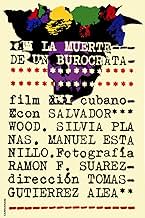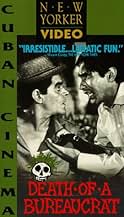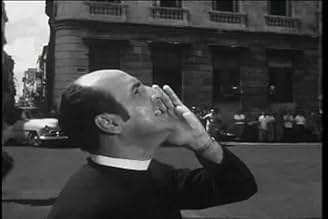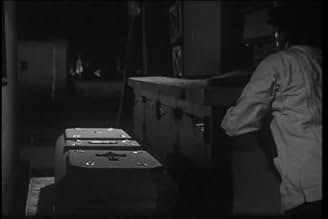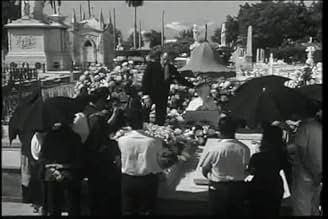CALIFICACIÓN DE IMDb
7.6/10
1.6 k
TU CALIFICACIÓN
Agrega una trama en tu idiomaA young man attempts to fight the system in an entertaining account of bureaucracy amok and the tyranny of red tape.A young man attempts to fight the system in an entertaining account of bureaucracy amok and the tyranny of red tape.A young man attempts to fight the system in an entertaining account of bureaucracy amok and the tyranny of red tape.
- Dirección
- Guionistas
- Elenco
- Premios
- 1 premio ganado y 1 nominación en total
Opiniones destacadas
Although I have consciously kept my foreign film viewing to a minimum during this Christmas season, I couldn't resist purchasing this one (whose release on R2 DVD from Network came literally out of left field) and watching it instantly, given its opening dedication to many an exponent of cinema (more on this later). As far as I can recall, it also marks my introduction to Cuban cinema which, as can be surmised by the title, deals with the country's social structure; considering the political situation of the time in which it was made, this is hardly a surprise
but, what is unexpected is the fact that it treats the subject matter as black comedy!
The plot resolves itself in a succession of ironic developments with respect to the pension coming to the widowed wife of a veritable working-class hero (his sculpting endeavors and unfortunate demise are depicted via a stylized animation sequence): to get it, she needs her husband's union card but his equally proletarian comrades had it buried with him as a symbolic gesture. Her milquetoast nephew, who's really the hero of the film, decides to have the body exhumed but, officially, two years have to pass before this can be legitimately done; so, he hires two men to steal the body and then proposes to have it buried once more but, since there's no record of it having been exhumed in the first place, technically, this isn't possible either. And so on and so forth, with numerous episodes involving legal red tape (which ought to bring a smile and a strong sense of empathy to anyone who has ever dealt with a government entity) until the young man is literally driven to madness and murder! The film, then, ends with the funeral of this other bureaucrat
Going back to that dedication I mentioned earlier, the full text (typed on screen along with the film's full credits at the very beginning and signed by the director) reads thus: "The film is dedicated to Luis Bunuel, Oliver Hardy, Stan Laurel, Ingmar Bergman, Harold Lloyd, Akira Kurosawa, Orson Welles, Juan Carlos Tabio, Elia Kazan, Buster Keaton, Jean Vigo, Marilyn Monroe and all those who, in one way or another, have taken part in the film industry since the days of Lumiere." This is no faint praise, either, as THE DEATH OF A BUREAUCRAT features a handful of Bunuelian dream sequences and a general mockery of Christian burial services (one highly amusing little scene is when the nephew pilfers ice cubes for his drink from his aunt's supply who is forever breaking ice in order to preserve her husband's body!); a delightful tit-for-tat routine of wanton destruction occurring, of all places, at the cemetery (and which even develops into a Laurel & Hardy-style custard pie fight!); and, at one point, we're also treated to some Harold Lloyd-type antics on a ledge when our hero finds himself locked inside an office building!
Director Tomas Gutierrez Alea is himself generally considered to be the finest Cuban film-maker and among his other works worth mentioning are THE TWELVE CHAIRS (1962; which is also available on R2 DVD from Network and the 1970 Mel Brooks version of which, incidentally, I've just acquired), MEMORIES OF UNDERDEVELOPMENT (1968), THE LAST SUPPER (1976) and the Oscar nominated STRAWBERRY AND CHOCOLATE (1994); the local DVD shop has the latter available for rental and, as a result of this positive experience with Cuban cinema, I will certainly be giving it a spin one of these days
The plot resolves itself in a succession of ironic developments with respect to the pension coming to the widowed wife of a veritable working-class hero (his sculpting endeavors and unfortunate demise are depicted via a stylized animation sequence): to get it, she needs her husband's union card but his equally proletarian comrades had it buried with him as a symbolic gesture. Her milquetoast nephew, who's really the hero of the film, decides to have the body exhumed but, officially, two years have to pass before this can be legitimately done; so, he hires two men to steal the body and then proposes to have it buried once more but, since there's no record of it having been exhumed in the first place, technically, this isn't possible either. And so on and so forth, with numerous episodes involving legal red tape (which ought to bring a smile and a strong sense of empathy to anyone who has ever dealt with a government entity) until the young man is literally driven to madness and murder! The film, then, ends with the funeral of this other bureaucrat
Going back to that dedication I mentioned earlier, the full text (typed on screen along with the film's full credits at the very beginning and signed by the director) reads thus: "The film is dedicated to Luis Bunuel, Oliver Hardy, Stan Laurel, Ingmar Bergman, Harold Lloyd, Akira Kurosawa, Orson Welles, Juan Carlos Tabio, Elia Kazan, Buster Keaton, Jean Vigo, Marilyn Monroe and all those who, in one way or another, have taken part in the film industry since the days of Lumiere." This is no faint praise, either, as THE DEATH OF A BUREAUCRAT features a handful of Bunuelian dream sequences and a general mockery of Christian burial services (one highly amusing little scene is when the nephew pilfers ice cubes for his drink from his aunt's supply who is forever breaking ice in order to preserve her husband's body!); a delightful tit-for-tat routine of wanton destruction occurring, of all places, at the cemetery (and which even develops into a Laurel & Hardy-style custard pie fight!); and, at one point, we're also treated to some Harold Lloyd-type antics on a ledge when our hero finds himself locked inside an office building!
Director Tomas Gutierrez Alea is himself generally considered to be the finest Cuban film-maker and among his other works worth mentioning are THE TWELVE CHAIRS (1962; which is also available on R2 DVD from Network and the 1970 Mel Brooks version of which, incidentally, I've just acquired), MEMORIES OF UNDERDEVELOPMENT (1968), THE LAST SUPPER (1976) and the Oscar nominated STRAWBERRY AND CHOCOLATE (1994); the local DVD shop has the latter available for rental and, as a result of this positive experience with Cuban cinema, I will certainly be giving it a spin one of these days
10Aw-komon
Forget post-revolutionary Cuba; right here in America, in 2000, there is enough bureaucracy for the comedic lessons of Alea's great film about people's propensity to conform at all costs to absurd restrictions from 'above' and cause misery to others rather than risk the slightest insecurity to themselves, to be driven home painfully. This is a really funny film but one that makes you think, like Tati's 'Playtime,' Fellini's early films or some of Bunuel's. This film is deeply critical and ridicules everything that is part and parcel of government enforced socialism. You can't fault Castro for not having a sense of humor, if he agreed to release this film. Leo Beower's understated music is, as always, excellent.
When lent this film by a Spanish professor, my expectations were not high -- I had no idea this film from the early years of revolutionary Cuba was by Gutierrez Alea, Tinton, the director of Strawberries and Chocalate. Now, having seen the film, I wonder how it is that such a wonderful, imaginative work is not better known. For a good laugh, this can hardly be beat.
"Death of a Bureaucrat"(Muerte de un burocrata) is the story of a body that just can't get in the ground, and the frustrations suffered by the deceased's family in trying to address this situation. With the themes of bureaucratic rigidity, death, burial and the challenges of (then) modern-day Cuban life, we see linkages to Tinton's last work, "Guantanamera". The director has played with a range of techniques borrowed from some of the greats -- we find Bunuel's dream sequences, Chaplin's battles with the machine, and Keaton's daring-do. Hopefully, with the success of Tinton's final works, some of his earlier works will come into vogue.
"Death of a Bureaucrat"(Muerte de un burocrata) is the story of a body that just can't get in the ground, and the frustrations suffered by the deceased's family in trying to address this situation. With the themes of bureaucratic rigidity, death, burial and the challenges of (then) modern-day Cuban life, we see linkages to Tinton's last work, "Guantanamera". The director has played with a range of techniques borrowed from some of the greats -- we find Bunuel's dream sequences, Chaplin's battles with the machine, and Keaton's daring-do. Hopefully, with the success of Tinton's final works, some of his earlier works will come into vogue.
She is the model in the bikini holding a hammer 1 hour into the movie. Her name is Regina Amador, top model at Tropicana Club Havana, Cuba 1962-1968.
For a movie that was released 40 years ago, this one has aged particularly well.
I think I'm not exaggerating by saying that this movie represents something of a precursor of the Monty Python movies, alas, not so irreverent. But the way it deals with the topic, and the imaginative gags and inter-cuts that it has, can only remind you of those English geniuses.
But is also many things. A little of Three Stooges here. Even a little Chaplin there...
How you can make something funny out of the situation of a family (the main character and his aunt) that cannot get his relative buried, and have to keep him home until the red tape is overpowered, without losing sight of the human touch and their despair?. You'd need a very skillful director to juggle all that successfully.
I Haven't seen or heard of a Latin American movie like this one. It must be considered a milestone in Latin American cinema (and certainly, in world cinema). Regretfully, not the style, or the genius of the director Tomás Gutiérrez Alea, seem to have had dedicated followers. I'm afraid that has something to do with the Cuban origin, not because of Cuban backlash, but because of lack of interest or attention over Cuban art during the 60's. Latin America has produced a lot of movies, but most of them are dead serious. When somebody comes with the idea of a comedy, it is very light, unfunny and clichéd, nothing to tell the world about, with very few exceptions.
That's why I was surprised by LA MUERTE DE UN BURÓCRATA and I highly recommend it, if you can find it somehow.
I think I'm not exaggerating by saying that this movie represents something of a precursor of the Monty Python movies, alas, not so irreverent. But the way it deals with the topic, and the imaginative gags and inter-cuts that it has, can only remind you of those English geniuses.
But is also many things. A little of Three Stooges here. Even a little Chaplin there...
How you can make something funny out of the situation of a family (the main character and his aunt) that cannot get his relative buried, and have to keep him home until the red tape is overpowered, without losing sight of the human touch and their despair?. You'd need a very skillful director to juggle all that successfully.
I Haven't seen or heard of a Latin American movie like this one. It must be considered a milestone in Latin American cinema (and certainly, in world cinema). Regretfully, not the style, or the genius of the director Tomás Gutiérrez Alea, seem to have had dedicated followers. I'm afraid that has something to do with the Cuban origin, not because of Cuban backlash, but because of lack of interest or attention over Cuban art during the 60's. Latin America has produced a lot of movies, but most of them are dead serious. When somebody comes with the idea of a comedy, it is very light, unfunny and clichéd, nothing to tell the world about, with very few exceptions.
That's why I was surprised by LA MUERTE DE UN BURÓCRATA and I highly recommend it, if you can find it somehow.
¿Sabías que…?
- TriviaThe girl who plays the girl n the black bikini with a hammer in the "Death to Bureaucracy" parade is Regina Amador, top model at Tropicana Club Havana, Cuba 1962-1968.
- Créditos curiososDedicated to Luis Buñuel, Stan Laurel and Oliver Hardy, Ingmar Bergman, Harold Lloyd, Akira Kurosawa, Orson Welles (as Orson Wells), Juan Carlos Tabio, Elia Kazan, Buster Keaton, Jean Vigo, Marilyn Monroe.
- Bandas sonorasCoja el paso
Written by Frank Dominguez
Selecciones populares
Inicia sesión para calificar y agrega a la lista de videos para obtener recomendaciones personalizadas
- How long is Death of a Bureaucrat?Con tecnología de Alexa
Detalles
- Fecha de lanzamiento
- País de origen
- Idioma
- También se conoce como
- Death of a Bureaucrat
- Locaciones de filmación
- La Habana, Cuba(town of the action)
- Productora
- Ver más créditos de la compañía en IMDbPro
Taquilla
- Total a nivel mundial
- USD 3,323
- Tiempo de ejecución
- 1h 25min(85 min)
- Color
- Mezcla de sonido
- Relación de aspecto
- 1.66 : 1
Contribuir a esta página
Sugiere una edición o agrega el contenido que falta

